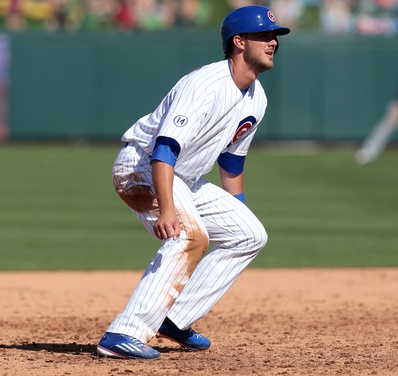Joe Maddon was well-known as one of the funkiest managers in baseball during his time with the Tampa Bay Rays. Maddon often implemented the infield shift before it was popular and even batted his pitcher eighth in interleague games. The Rays are well-known as one of the more sabermetricly inclined organizations, and Maddon was a perfect fit.
We all know that Maddon likes to his teams to be aggressive on the basepaths, and he did it a lot while in Tampa. During his tenure, Tampa led all of baseball in the amount of times their runners went first to third on a single. They were also first in stolen-base attempts and stolen bases. The Cubs during that time frame, well, didn’t run so much. They ranked only 27th in the majors in stolen-base attempts and stolen bases. They played a much more conservative game on the basepaths. Here’s the difference between Maddon’s Rays and the Cubs from 2006-2014.
| Team | SB Attempts | SB | Successful SB% |
| Rays | 1627 | 1198 | 73.6% |
| Cubs | 1017 | 696 | 68.4% |
That’s quite the difference over nine seasons. Maddon’s only been the manager on the North Side for 13 games, but we can already see a difference in the running game for the Cubs. Through Wednesday, the Cubs are tied for second in the majors in both stolen bases (16) and stolen base attempts (18).
Maddon’s arguably the poster child of what managers of the future could look like. In a stat-forward era where laying down the sac bunt is heavily frowned upon, something that caught my eye was how frequently Maddon’s Rays attempted the sac bunt last season. Last season the Rays attempted 71 non-pitcher sac bunts, the most in baseball. Of those non-pitcher attempts, they were successful 41 times, which was the second most in baseball behind only the Cleveland Indians. As sabermetric-minded folk have stated plenty of times, sac bunts are generally not a good thing. This is evident as the Rays sac bunt opportunities resulted in a -0.4 WPA, and -2.0 RE24.
It’s not a totally fair comparison, since the Rays and Cubs play in different leagues, but in 2014, the Cubs attempted 36 non-pitcher sac bunts, and were successful 24 times, tied for 16th in baseball and 7th in the NL. The Cubs sac-bunt attempts as a whole resulted in a -2.3 WPA, and -21 RE24.
Through the first 13 games of the season, the Cubs have already attempted six bunts, five of which were by non-pitchers. Of the six attempts, four were successful sacrifices, one of which resulted in an error. Of the two that were not successful, one resulted in a bunt single, which can’t be considered a successful sacrifice because it resulted in a hit. The one sac attempt that didn’t pan out was from Kyle Hendricks and the only pitcher attempt. These attempts have resulted in a 0.2 WPA this season, and an RE24 of 1.0, which is much better than last season, granted in a very small sample size. The Cubs are tied for the seventh-most sac bunts in baseball. Even though their sacrifice attempts have yielded positive results thus far, sac bunts likely won’t yield the same positive results throughout the season.
As he did in Tampa, we’ve once again seen a Maddon-led team being extremely aggressive on the basepaths. Runners have been consistently going first to third. He’s swiping bags with Anthony Rizzo (two in one game) and he’s already called multiple hit and runs or run and hits with Kris Bryant on the bases. Maddon isn’t afraid to bunt, but with the way this team has succeeded in taking the extra bag, they’re avoiding giving away outs at a very impressive rate. With the offensive production the Cubs expect to get from their two through five of Jorge Soler, Rizzo, Bryant, and Starlin Castro, you really don’t want to give away outs. If this team can continue to be aggressive and remain successful taking the extra base when the opportunity arises, it could mean extra opportunities with men in scoring position for an already potent offense. That’s something any Cubs fan can appreciate.

Something that was mentioned on a recent Effectively Wild Podcast, that wasn’t fully fleshed, out was a comment, ‘as the game becomes more low scoring and runs are at a premium would there be an increase in the Sac Bunt?’. Is it possible that the value of the Sac Bunt is greater now than it was 10 years ago since the game has continued down a near endless path towards low scoring?